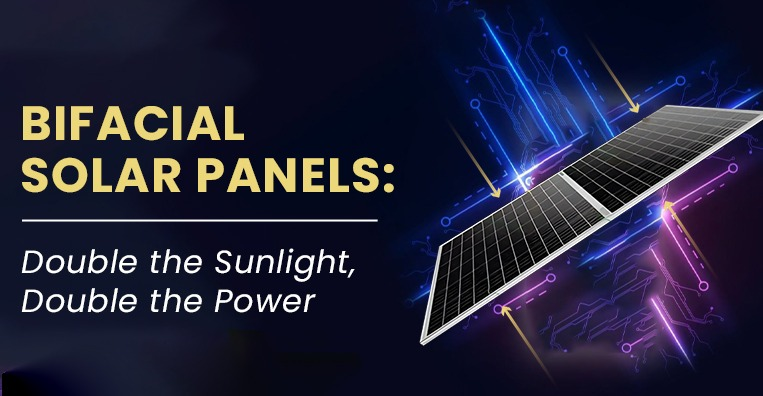In the dynamic realm of renewable energy solutions, solar power stands out as a beacon of hope, offering a pathway to a cleaner, greener future. Among the myriad innovations in solar technology, bifacial solar panels emerge as a revolutionary force, poised to reshape the landscape of solar energy generation. These cutting-edge panels possess the remarkable ability to capture sunlight not just from the front, but also from the rear side, unlocking unprecedented potential for energy generation. In this exploration, we embark on a journey to uncover the brilliance of bifacial solar panels, delving into their workings, unique attributes, pricing dynamics, benefits, and limitations.
Working of Bifacial Solar Panels:-
Bifacial solar panels are like regular solar panels but with a special ability: they can collect sunlight not just from the front but also from the back. Here’s how they work:
- Capturing Sunlight from Both Sides: Traditional solar panels only absorb sunlight from the side facing the sun. Bifacial panels, however, have a see-through back layer that lets sunlight pass through and reach the backside.
- Making Use of Reflected Light: Besides direct sunlight, these panels can also use light that bounces off surfaces like the ground or nearby buildings. This means they can produce electricity from both direct and reflected sunlight.
- Maximizing Energy Generation: By collecting sunlight from two directions, bifacial panels can generate more electricity compared to regular panels. This makes them really efficient, especially in places where there’s a lot of sunlight bouncing around.
In simple terms, bifacial solar panels are like solar superheroes—they can absorb sunlight from the front and the back, making them super-efficient at generating electricity from the sun!
Benefits of Bifacial Solar Panels
1. Increased Energy Output:
One of the primary advantages of bifacial solar panels is their higher energy yield compared to traditional panels. By capturing sunlight from both sides, they can generate more electricity, especially in areas with high albedo, where there’s significant sunlight reflection.
2. Enhanced Durability:
Bifacial panels often feature durable materials, such as double-layered glass, which can improve their longevity and resistance to environmental factors like hail, wind, and temperature fluctuations.
3. Versatility:
These panels are suitable for various installation scenarios, including ground-mounted arrays, rooftop installations, and even vertical installations on building facades. Their versatility makes them adaptable to different environments and applications.
4. Improved Performance in Diffuse Light Conditions:
Bifacial panels are particularly effective in diffuse light conditions, such as cloudy days or early mornings and late afternoons when sunlight intensity is lower. They can capture more ambient light, increasing energy production compared to conventional panels.
5. Aesthetics:
With their sleek, modern design and transparency, bifacial solar panels can add aesthetic value to buildings and landscapes, making them a preferred choice for architectural integration.
Limitations of Bifacial Solar Panels
- Shading: Bifacial panels are more sensitive to shading than traditional panels. Even partial shading of the rear side can significantly reduce their efficiency. Therefore, careful planning and installation are essential to avoid shading issues.
- Maintenance: The transparent backsheet of bifacial panels can be more prone to scratching or damage compared to the opaque backsheet of traditional panels. This may require additional maintenance to ensure optimal performance.
- Market Availability: Bifacial solar panels are still relatively new compared to traditional panels, which means they may not be as readily available in the market. Limited options and suppliers could pose challenges for consumers looking to invest in this technology.
Comparing Bifacial and Monofacial Solar Panels: A Comprehensive Overview
| Aspect | Bifacial Solar Panels | Monofacial Solar Panels |
| Absorption of sunlight | Capture sunlight from both front and back sides | Capture sunlight from only one front-facing side |
| Design | Have a translucent backsheet to allow light penetration | Typically have an opaque backsheet |
| Efficiency | Generally higher efficiency due to dual-sided capture | Efficiency depends solely on front-side sunlight capture |
| Cost | May be more expensive due to additional materials | Typically more cost-effective due to simpler design |
| Installation | May require specific mounting to maximize effectiveness | Standard installation practices apply |
| Suitability for environments | Effective in areas with high albedo (e.g., snow-covered regions, reflective surfaces) | Suitable for various environments, but less effective in areas with low albedo |
| Maintenance | Potentially more prone to scratching or damage to the backsheet | Less sensitive to backsheet damage due to opaque design |
| Shading sensitivity | More sensitive to shading, as it affects both front and backside capture | Shading mainly affects the front side, minimizing overall impact |
| Market maturity | Relatively newer technology, still evolving and developing | Established technology with standardized practices |
Price of Bifacial Solar Panels in India
The cost of bifacial solar panels in India can vary based on several factors, including the manufacturer, size, efficiency, and quantity purchased. Factors Influencing Price:
- Manufacturer Reputation: Bifacial panels from reputable manufacturers may come at a premium but often offer better warranties and performance guarantees.
- Efficiency: Higher efficiency panels are generally pricier, but they can generate more energy over their lifespan, potentially justifying the additional cost.
- Size: The physical dimensions of the panels can affect the price. Larger panels typically cost more due to increased material usage.
- Location: Geographic location can influence panel prices due to shipping costs and availability of materials.
Cost Consideration:-
When evaluating the cost of bifacial solar panels, it’s essential to take a long-term view. While they may have a higher upfront cost, they often provide better returns on investment due to their increased efficiency and energy production. Here are some cost-related considerations to keep in mind:
- Initial Investment: It’s important to consider this initial investment in the context of the panel’s lifespan and energy-generating capabilities.
- Long-Term Savings: Despite the higher initial cost, bifacial panels can provide significant long-term savings on electricity bills. Their ability to capture sunlight from both sides allows them to generate more electricity, ultimately reducing reliance on grid power and lowering energy costs over time.
- Return on Investment (ROI): Bifacial panels often offer a better ROI compared to monofacial panels, thanks to their increased energy production and efficiency. While the payback period may be slightly longer due to the higher upfront cost, the overall savings and financial benefits over the panel’s lifespan can outweigh this initial investment.
- Maintenance and Durability: Consideration should also be given to maintenance costs and durability. Bifacial panels are generally more durable and less prone to degradation over time, resulting in lower maintenance expenses and longer service life compared to traditional panels.
- Incentives and Rebates: Government incentives, tax credits, and rebates may further offset the cost of bifacial solar panels, making them a more affordable option for homeowners and businesses. It’s essential to explore available incentives in your area to maximize cost savings.
- Future Energy Price Trends: Factoring in future energy price trends is also crucial when evaluating the cost of bifacial solar panels. As energy prices continue to rise, investing in solar energy can provide a hedge against future electricity cost increases, further enhancing the financial benefits of bifacial panels.
Conclusion:- In conclusion, bifacial solar panels represent a significant advancement in solar technology, offering increased efficiency and versatility compared to traditional monofacial panels. By capturing sunlight from both the front and back sides, these panels can generate more electricity, especially in areas with high albedo or reflective surfaces.







Leave a Reply